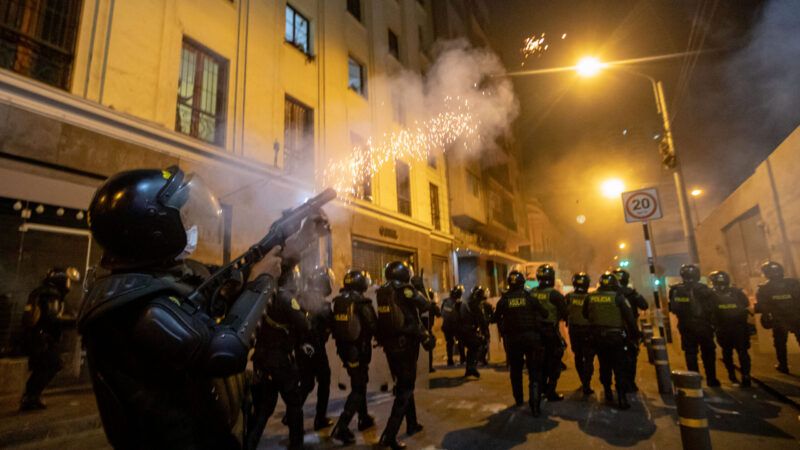Curfews and Restrictions: Peru's Regime Cracks Down
Twenty-five people have died this month amid nationwide protests.

The impeachment of Peru's populist president has set off a political and constitutional firestorm, prompting nationwide protests against the government and creating a diplomatic rift with Mexico. Peru's Congress has preliminarily backed a proposal that will allow for presidential and legislative elections in April 2024, two years ahead of schedule, according to the Associated Press.
Popular protests against the government have raged in Peru since lawmakers voted to remove President Pedro Castillo from office two weeks ago. Castillo, who emerged as the surprise winner of a heavily contested presidential election in July 2021, had already been the subject of two separate impeachment inquiries led by the opposition-controlled Congress over corruption allegations. After announcing he would dissolve the Congress and rule by decree, a move many observers decried as a "self-coup," Congress moved expeditiously to remove Castillo from office, arrest him on corruption and treason charges, and install his vice president, Dina Boluarte, as president. The removal of Castillo immediately sparked nationwide protests, especially in the country's interior and southern Andean regions where large sections of Peru's indigenous and mixed-ancestry communities live.
Peru's indigenous communities, which have largely felt neglected and dismissed by the political elite in the capital of Lima, have been at the forefront of these protests. To them, Castillo, who drew much of his electoral support from the interior and the Andean south, was a champion of indigenous interests, alleged corruption notwithstanding.
"I want my president to be freed," one indigenous woman protesting in Lima told El Pais, a Spanish newspaper. "He is a good, upright, correct man, who thinks of the cholada [the mestizos and indigenous people]."
"He has a good heart, they [Congress] didn't let him govern," she continued.
In response to the protests, Boluarte declared a 30-day national state of emergency, issuing curfews, restricting movement and assembly in the country, and mobilizing the country's national police, which has responded aggressively to demonstrations. Over 25 people have died in clashes between protesters and police. Human rights groups have criticized Boluarte and the Peruvian government for "state repression against protesters" and are calling on the government to investigate deaths and injuries inflicted upon protesters. The Peruvian government has also expelled Mexico's ambassador to the country following Mexico's offers to grant asylum to Castillo, creating a new diplomatic rift in Latin America.
The Castillo impeachment and the accompanying protests are just the latest flashpoints in a prolonged constitutional crisis that has mired Peru over the last six years. While many ex-presidents of Peru have faced allegations of corruption during and after their presidencies, Peru has seen an unprecedented wave of impeachments against its presidents in recent times. Three of the country's last six presidents have faced impeachment inquiries; two of them, Castillo and Martín Vizcarra, were removed from office. Many of these impeachments have been led by the country's far-right opposition parties, which control a majority of the seats in Peru's Congress.
These parties have seen a resurgence in popularity since the early 2010s. They draw on the ideological vision of Alberto Fujimori, the country's controversial authoritarian ex-president who was convicted of crimes against humanity for his administration's repressive response to terrorist acts by Shining Path and the Túpac Amaru Revolutionary Movement, two leftist guerilla groups that ravaged the country during the later half of the 20th century. The Peruvian Constitution grants Congress the power to impeach presidents without cause, which the country's Fujimorist political parties have used against the anti-Fujimorist politicians that have won national presidential elections over the last decade.
There are worries that this wave of protests, and their aftermath, could mark the end of Peru's neoliberal economic model—the "Lima consensus" experts argue has improved quality of life across a variety of socioeconomic indicators. Although the Peruvian economy has thus far held strong amid this wave of political instability, as a result of the country's low inflation rates and large foreign reserves, the country nevertheless faces economic headwinds. Peru has seen lower-than-expected gross domestic product growth and concerns have also emerged about the impacts of the protests and political chaos on the global supply chain. Peru is the second-largest producer of copper in the world and is a major supplier of fruits for the global food market. Meanwhile, Peru's tourism industry has suffered immediate losses, as the political turmoil has prompted the evacuation of tourists from the country and many trip cancellations.
